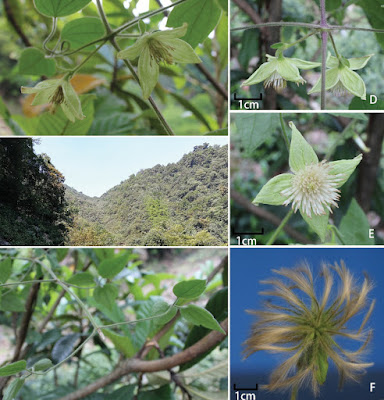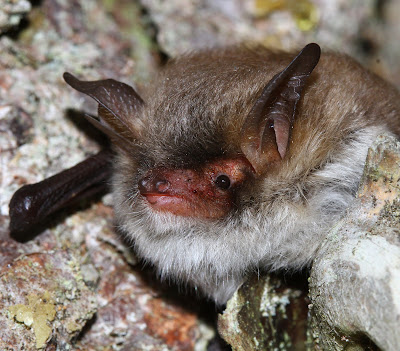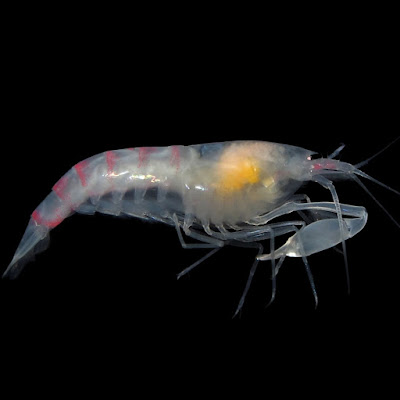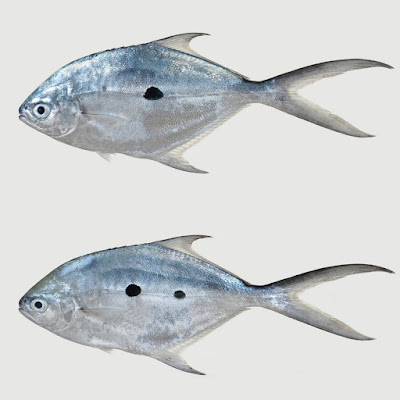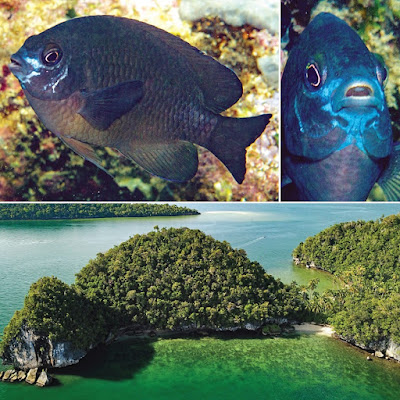[Most Recent Entries] [Calendar View]
Monday, August 5th, 2019
| Time | Event | ||||||
| 2:41a | [Botany • 2019] Clematis guniuensis (Ranunculaceae) • A New Species from Eastern China
Abstract Clematis guniuensis sp. nov., a new narrowly endemic species of Clematis, is described and illustrated from the Huangshan Mountains of Eastern China. A description of C. guniuensis is presented along with illustrations, photographs and diagnostic differences between the new species and its putative close allies. Keywords: Anhui, Early diverging eudicots, Ranunculales, Taxonomy
Clematis guniuensis W.Y.Ni, R.B.Wang & S.B.Zhou, sp. nov. Diagnosis: Resembles C. florida Thunb. and C. huchouensis Tamura but can be distinguished from the former one by puberulous leaflet blades, longer petiole, larger flowers with light green sepals, longer stamens and white filaments and from the latter by its longer petioles, 3-lobed leaflet blades, shorter pedicel, larger flowers, 4 sepals, filaments about 3–5 times the length of the anther, persistent style 1.5–2 cm long, and yellow plumose. ... Etymology: The specific epithet is derived from the type locality, Guniujiang National Nature Reserve. Vernacular name: Gǖ Niǘ Tiě Xiãn Lián (Chinese pronunciation); 牯牛铁线莲 (Chinese name). Distribution and habitat: To date, C. guniuensis is only known from the type locality, Guniujiang National Nature Reserve, Huangshan City, Anhui Province (Fig. 4). Currently the species is known from a few collections and there is only one known population with ca. 20 individuals at the type locality. The species is mostly found in tea plantations or forest edges along valleys of evergreen broad-leaved forests, at an elevation of 1,500 m a.s.l. Rong-Bin Wang, Wei-Yong Ni, Wen-Jing Xu, Zheng-Wen Gui and Shou-Biao Zhou. 2019. Clematis guniuensis (Ranunculaceae), A New Species from Eastern China. PhytoKeys. 128: 47-55. DOI: 10.3897/phytokeys.128.33891 | ||||||
| 3:27a | [Mammalogy • 2018] Myotis crypticus & M. zenatius • Two New Cryptic Bat Species within the Myotis nattereri Species Complex (Vespertilionidae, Chiroptera) from the Western Palaearctic
Abstract The Myotis nattereri species complex consists of an entangled group of Western Palaearctic bats characterized by fringing hairs along the rear edge of their uropatagium. Some members are relatively common while others are rare but all forms are morphologically very similar and their taxonomy is unresolved. Recent studies based on different molecular markers have shown that several major and unexpected lineages exist within this group of forest-dwelling bats. All the mitochondrial and nuclear markers tested to date have shown that these major lineages evolved as fully independent and coherent units and therefore each qualifies as distinct species. In the absence of proper morphological diagnosis, these lineages are informally referred to in the literature under different names. We explore here the external and craniodental variation of these lineages. Although all morphological measurements were overlapping between these lineages, we show that lineages can be completely discriminated in a multivariate morphometric space. Consistent with previous molecular reconstructions, these four major lineages represent two pairs of related species, each represented by a named species (Myotis nattereri s. str. and M. escalerai, respectively) and by unnamed forms (Myotis sp. A and Myotis sp. B, respectively). Herein we describe formally these two unnamed forms to clarify the taxonomy within this species complex. This new taxonomic view has important implication for the protection of these species, as three of the four taxa must now be considered as range-restricted species in need of conservation actions. KEYWORDS: cryptic species, DNA, systematics, speciation, taxonomy
Myotis crypticus sp. nov. Ruedi, Ibáñez, Salicini, Juste and Puechmaille Synonyms: Myotis nattereri (Kuhl, 1817): Miller (1912) (partim): Simmons (2005) (partim). Myotis nattereri North Iberia (Kuhl, 1817): Ibáñez et al. (2006) Myotis sp. (Mayer et al., 2007). Myotis sp. A (García-Mudarra et al., 2009). Myotis sp. A and Clade A (Salicini et al., 2011). Myotis sp. A and M. sp A (Salicini et al., 2013). Myotis sp. A and Myotis sp. C (Galimberti et al., 2012). Myotis sp. A (Puechmaille et al., 2012): (Allegrini and Puechmaille, 2013). M. nattereri 2 (Kuhl, 1817): Ruedi et al. (2013). Myotis nattereri (Kuhl, 1817): Bogdanowicz et al. (2015). Diagnosis: Externally, the combination of a long, S-shaped calcar without epiblema, very long and pointed tragus, smooth and unnotched rear edge of ears and presence of stiff hairs along the uropatagium margin distinguish M. crypticus sp. nov. and other members of the M. nattereri species complex from all remaining Eurasian Myotis taxa. The wing membrane insertion at the base of the toe (Fig. 4) as described by Puechmaille et al. (2012) and the pattern of curved nature of the stiff uropatagial hairs (Fig. 5) further distinguish M. crypticus sp. nov. from species related to the M. escalerai clade. The skull shape is very similar to that of M. nattereri s. str. but is relatively more slender in M. crypticus sp. nov., particularly the rostral and occipital regions, which seem narrower in the latter species (Fig. 3). Finally, numerous diagnostic mutations in both mitochondrial and nuclear sequences clearly support the uniqueness of M. crypticus sp. nov. compared to any other species in this group. Etymology: The epithet crypticus is derived from the Greek ‘kryptos’, which means hidden or concealed, in reference to this species' long history of remaining undetected. Proposed vernacular names: Kryptisches Mausohr (German), cryptic myotis (English), murin cryptique (French), murciélago ratonero críptico (Spanish). Distribution: Animals identified as M. crypticus sp. nov. based on molecular characters were recorded in mountain areas of provinces of central and northern Spain (Salicini et al., 2011), southern France (Salicini et al., 2011; Puechmaille et al., 2012), across the Italian Peninsula (Salicini et al., 2011; Galimberti et al., 2012) and probably to the adjacent southwestern parts of Austria (Mayer et al., 2007). Based on nuclear genetic markers (unpublished data), marginal areas to the north and west of the Alps, e.g. in western Switzerland or Rhône-Alpes (France), are also occupied by M. crypticus sp. nov. However, the northern and eastern limits of the distribution of M. crypticus sp. nov. notably in relation to the occurrence of M. nattereri s. str., are unknown. Furthermore, as the populations from Sicily and southern Italy show important genetic discontinuities (Salicini et al., 2013; Bogdanowicz et al., 2015), they deserve further scrutiny as they might present further taxonomic complexity. Myotis zenatius sp. nov. Ibáñez, Juste, Salicini, Puechmaille and Ruedi Synonyms: Myotis nattereri (Kuhl, 1817): Brosset (1963): Gaisler (1983): Gaisler (1983–1984): Horáček and Hanák (1984) (partim): Kowalski et al. (1986): Aulagnier and Thevenot (1986): Kowalski and Rzebik-Kowalska (1991). Myotis nattereri (Kuhl, 1817): Horáček et al. (2000) (partim): Benda et al. (2004): Simmons (2005) (partim): Dieuleveut et al. (2010). Myotis sp. B (García-Mudarra et al., 2009): (Puechmaille et al., 2012). Myotis sp. B and Clade B (Salicini et al., 2011). Myotis sp. B and Clade B (Salicini et al., 2013). Diagnosis: Externally, M. zenatius sp. nov. shares all the char acters previously referred to for M. crypticus sp. nov. that distinguish this and the other members of the M. nattereri complex from all remaining European Myotis taxa. The wing membrane is inserted in the mid-metatarsus (Fig. 4) as in M. escalerai but contrary to M. crypticus sp. nov. and M. nattereri s. str. that have the wing membrane inserted at the base of the toe (Puechmaille et al., 2012). This character was first used by Cabrera (1904) in the original description of M. escalerai and later validated by Puechmaille et al. (2012). Similarly, the characteristic stiff fringing hairs bordering the tail membrane show the same distinct pattern described for M. escalerai by Agirre-Mendi and Ibáñez (2012); accordingly, the hairy edge of this membrane looks thicker than in M. nattereri and M. crypticus sp. nov. due to the presence of an additional line of relatively long and conspicuous stiff hairs facing inwards (Fig. 5). The sharing of these two morphological characters between M. escalerai and M. zenatius sp. nov. is in agreement with their phylogenetic relationships, which place them as sister species, while they are distinct from M. nattereri s. str. and M. crypticus sp. nov. Nevertheless, the darker and more greyish dorsal fur colour in adult M. ze natius sp. nov. (resembling a juvenile coloration in other Myotis species) distinguishes the new species from adult M. escalerai. Again, the skull morphology is very similar between M. zena tius sp. nov. and M. escalerai, but is in general more delicate in the new species and slightly smaller in all dimensions (as previously described by Benda et al., 2006), except for the postorbital constriction which is wider in M. zenatius sp. nov. (Table 2). The braincase is also relatively broader and more globose in the new species than in M. escalerai). Etymology: The epithet zenatius is derived from the word ‘Zanatah’ which refers to a little known Berber tribe that lived in the Maghreb region of North Africa in the Middle Ages. The Zanatah people were famous for their horse riding skills and mobility. Proposed vernacular names: Zenati Mausohr (German), Zenati myotis (English), murin Zenati (French), murcielago ratonero Zenate (Spanish). Distribution: The species Myotis zenatius sp. nov. is probably endemic from the Mediterranean region of Morocco and Algeria, and possibly Tunisia. In Morocco it is very rare, known only from three localities in the central part and western coast (Benda et al., 2004), and from one locality in the hills of Rekkam, in the eastern part of the country (Dieuleveut et al., 2010). We add in this study three new localities (see Supplementary Table S1 (01-AC-20-2-p-285–300_Supplement.pdf)) plus another one in Azrou (Ait-Sebaa) where six additional individuals were biopsied and released. In the Appendix of Salicini et al. (2013), the species is wrongly mentioned from Errachidia. The mistake stems from the switching between the similar names of two caves, Kef Azigza (near Errachidia) where M. zenatius sp. nov. does not occur, and Kef Aïssa (the correct locality). The species is thus rare but widely distributed across Morocco from the northern slopes of the Riff (near Tetouan) to the dry mountains of the Great Atlas (e.g. Wintimdouine Cave). The Atlas Mountains apparently delineate two distinct haplogroups (Salicini et al., 2013) that may represent distinct subpopulations. We can assume that the Algerian populations previously classified as M. nattereri (see e.g., Ko wal ski and Rzebik-Kowalska, 1991) represent M. ze natius sp. nov., given that the distance between the easternmost known locality from Morocco (Rekkam Hills — Dieuleveut et al., 2010) is only around 200 km far from the westernmost known locality from Algeria (near Tlemcen — Kowalski et al., 1986). The new species occurs in the northern parts of Algeria, where it is known only from three localities (Kowalski and Rzebik-Kowalska, 1991; Ahmim, 2017). As no specimen from this country has been analysed genetically, it is however unknown to which extent these represent interconnected or isolated subpopulations. Natural history: Very little is known about this species, which is one of the rarest bats in the Mediterranean. As most identified individuals were captured at cave roosts, including breeding females from nursery colonies, it shares with M. escalerai troglophilous habits through out the year. Such strong cave-dwelling habits mark a significant ecological contrast with the other two species (M. nattereri s. str. and M. crypticus sp. nov.), which roost preferably in tree holes during the summer. Furthermore, the maternity colonies of M. zenatius sp. nov. can reach up to 300 individuals (Kowalski et al., 1986; authors' unpublished data), which are distinctly larger than the tree-dwelling species. Javier Juste, Manuel Ruedi, Sébastien J. Puechmaille, Irene Salicini, and Carlos Ibáñez. 2019. Two New Cryptic Bat Species within the Myotis nattereri Species Complex (Vespertilionidae, Chiroptera) from the Western Palaearctic. Acta Chiropterologica. 20(2); 285-300. DOI: 10.3161/15081109ACC2018.20.2.001 A new species of bat was hiding in our forests ebd.csic.es/actualidad/-/asset_publisher/O | ||||||
| 3:52a | [Crustacea • 2019] Salmoneus venustus • On Three Symbiotic Species of the Alpheid Shrimp Genus Salmoneus Holthuis, 1955 (Malacostraca: Decapoda: Caridea) from the Indo-West Pacific, including One New to Science Abstract Three species of the alpheid shrimp genus Salmoneus Holthuis, 1955 associated with burrows of other decapod crustaceans are reported from various Indo-West Pacific localities. Salmoneus venustus sp. nov. is described based on material collected at two distant localities, Nha Trang Bay, southern Vietnam, the type locality of the new species, and the Yiti-Sifah region east of Muscat, northern Oman. Both specimens were collected with the aid of a suction pump applied to burrow entrances or mounds in muddy sand; the holotype was possibly associated with burrows of the callianassid ghost shrimp, Glypturus sp. Salmoneus venustus sp. nov. shares many characteristics with S. latirostris (Coutière, 1897), including the red banding of the pleon, but can be distinguished from S. latirostris and all other species of the genus by a unique combination of morphological characters. The large-sized Salmoneus brucei Komai, 2009 is reported from Sumba, central Indonesia, representing a significant southward extension of the species’ previously known distribution range and the first record since its original description. The callianassid ghost shrimp Lepidophthalmus cf. rosae (Nobili, 1904) is recorded as a new host of S. brucei. Finally, Salmoneus colinorum De Grave, 2004, associated with burrows of larger snapping shrimps from the Alpheus malabaricus Fabricius, 1798 species complex, is reported for the first time from Madang, Papua New Guinea, representing an eastward extension of the species’ previously known distribution range. Keywords: Crustacea, Alpheidae, Callianassidae, Salmoneus, decapod crustaceans, caridean shrimp, new species, new records, symbiosis, Indian Ocean, Pacific Ocean
Salmoneus venustus sp. nov. Etymology. The new species’ name is the Latin adjective venustus, for graceful or attractive, alluding to the pretty reddish colouration of the new species (contrasting to many bland, rather whitish or pale-yellowish species in the genus Salmoneus). | ||||||
| 4:40a | [Ichthyology • 2019] Trachinotus macrospilus • Indo-West Pacific Species of Trachinotus (Teleostei: Carangidae) with Spots on Their Sides as Adults, with Description of A New Sspecies Endemic to the Marquesas Islands
Abstract Diagnoses, comparisons, photographs and distribution maps are given for three previously described Indo-West Pacific species of Trachinotus that develop spots on their sides as adults. A new species, Trachinotus macrospilus, is described from the Marquesas Islands where it is endemic and the only species of the genus present. It differs from the other spotted Indo-West Pacific species most noticeably in having adults with only one or two large spots on each side, the largest spot larger than the iris diameter, and in having no large spot positioned above the pectoral fin. An identification key is given for all Indo-West Pacific species of Trachinotus and a molecular phylogeny, including 16 of the 20 valid species of Trachinotus is presented. A neotype is designated for Scomber botla Shaw, 1803. Key words: taxonomy, Carangidae, Trachinotus macrospilus n. sp., endemic, Marquesas Islands
Trachinotus macrospilus new species Marquesas dart Diagnosis. A species of Trachinotus in which adults have only 1 or 2 large black spots on their sides; the largest spot larger than iris diameter (usually smaller than iris diameter in T. baillonii and equal to or larger than eye diameter in T. botla and T. coppingeri), and in having no large spot positioned above the pectoral fin (adults of T. botla and T. coppingeri have 1 or 2 large spots above the pectoral fin). Height of largest spot plotted against head length is also larger than in T. baillonii (Fig. 6). Heights of dorsal- and anal-fin lobes of adults are also usually shorter than in the other three species (Fig. 7). Dorsal fin VI-I, 23‒26; anal-fin II-I, 23‒25; vomerine tooth patch usually chevron shaped and palatine tooth patch relatively long (Fig. 2B). Distribution. (Fig. 11) Endemic to the Marquesas Islands. Remarks. With a reported shore fish fauna of 495 species and 13.7% endemism (Delrien-Trottin et al., 2015), the Marquesas Islands have the third greatest species-level endemism for insular coral reef fishes in the Indo-Pacific. Easter Island, with a much smaller total fauna of only 169 marine fish species and a similar geographic size, has a 21.7% rate of endemism (Randall and Cea, 2011), exceeded only by Hawaii with about 25% endemism of its marine ichthyofauna (Randall, 2007). The Marquesas Islands are high islands of recent volcanic origin and, as discussed by Randall and Earle (2000), combined with their isolation both geographically and hydrographically (westernly South Equatorial Current and major upwelling events) has led to the high level of endemism of the ichthyofauna. Etymology. From the Greek makros (long, large) and spilos (spot), in reference to the relative height of the largest and usually single spot on the mid-side of the body of adults. William F. Smith-Vaniz and Stephen J. Walsh. 2019. Indo-West Pacific Species of Trachinotus with Spots on Their Sides as Adults, with Description of A New Sspecies Endemic to the Marquesas Islands (Teleostei: Carangidae). Zootaxa. 4651(1); 1–37. DOI: 10.11646/zootaxa.4651.1.1 | ||||||
| 10:12a | [Ichthyology • 2018] Pomacentrus bellipictus • A New Microendemic Species of Damselfish (Pisces: Pomacentridae) from the Fakfak Peninsula, West Papua, Indonesia
Abstract A new species of damselfish, Pomacentrus bellipictus, is described from 13 specimens, 37.7-67.9 mm SL, collected at the Kokas area of the Fakfak Peninsula, a portion of the Bird's Head Peninsula of western New Guinea (West Papua Province, Indonesia). It is distinguished from most similar species in the western Pacific Ocean by having 14 instead of 13 dorsal-fin spines. It also possesses a unique facial coloration consisting of highly contrasted blue areas around the mouth and onto the isthmus, below the eye, and along the margin of the preopercle. The only other species of Pomacentrus from the region with 14 dorsal spines that are also drab-brown when alive, P. fakfakensis and P. opisthostigma, are clearly distinguished on the basis of adult and juvenile color patterns and also show different habitat preferences. In addition, P. opisthostigma is distinguished from the other two species by fewer lateral-line scales (usually 15-17 vs. usual 18-19) and more gill rakers on the first arch (26-29 vs. 18-21). The three species co-occur in the Kokas area, but occupy different habitats: Pomacentrus bellipictus inhabits rocky, wave-washed shorelines in about 1-2 m depth, while the other two species occur in deeper water. The new species is apparently endemic to the small area around the Fakfak Peninsula, where several other microendemic reef fish species have been described. Key words: taxonomy, systematics, ichthyology, microendemic, coral-reef fishes, Indo-Pacific Ocean, Fakfak, Bird’s Head Peninsula.
Pomacentrus bellipictus, n. sp. Bluemouth Demoiselle Diagnosis. Dorsal-fin elements usually XIV (rarely XIII),12–14 (usually XIV,14); anal-fin elements II,12–15 (usually 14–15); pectoral-fin rays 17–19 (rarely 19); tubed lateral-line scales 17–19 (usually 18); total gill rakers on first arch 18–20 (rarely 20); body depth 1.8–2.0 (mean 1.9) in SL; scales absent on preorbital and suborbital; lower margin of suborbital series with 4–12 serrae; color in life mainly dark brown, nearly black, with contrasting blue areas around mouth (including isthmus), below eye, and along margin of preopercle; iris of adult mostly dark gray with a narrow bronze ring around pupil. Etymology. The species is named bellipictus (Latin: war-painted) with reference to its facial coloration and belligerent behaviour towards divers. The specific epithet is a masculine compound adjective.
Gerald R. Allen, Mark V. Erdmann and Nur I. Hidayat. 2018. Pomacentrus bellipictus, A New Microendemic Species of Damselfish (Pisces: Pomacentridae) from the Fakfak Peninsula, West Papua, Indonesia. Journal of the Ocean Science Foundation. 30, 1-10. oceansciencefoundation.org/josf30a.html |
| << Previous Day |
2019/08/05 [Calendar] |
Next Day >> |
